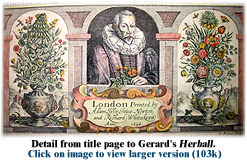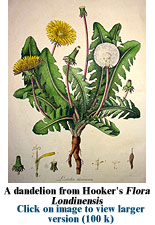Garden books in the Special Collections of the Barr Smith Library
Early herbals
Herbs were essential to the health
of a household and were a necessary part of the garden from early
times. The first books to describe plants and their properties and
virtues were the early herbals. Necessary to physicians and
apothecaries, herbalists and botanists as well as the
householder, they both described the plants as an aid to
identification, and provided receipts for remedies, pest control
and cosmetic treatments. The earliest herbals often depicted
crudely drawn plants including the body part or ailment that could
be cured using that herb.
botanists as well as the
householder, they both described the plants as an aid to
identification, and provided receipts for remedies, pest control
and cosmetic treatments. The earliest herbals often depicted
crudely drawn plants including the body part or ailment that could
be cured using that herb.
The earliest herbal in Special
Collections is De Medica Materia
Libri VI by Pedacius Dioscorides, printed in Venice in 1538.
Dioscorides (ca. 100AD) was said to have been a surgeon in Nero's
army, and based his work on the studies of Theophrastus
(370-285BC), a pupil of Plato and Aristotle and pioneer in natural
history who described more than 500 plant species and their
medicinal properties. Translated from the original Greek and passed
down in manuscript, this small and robust vellum bound volume lacks
illustrations, but was designed to be carried and consulted, and
has been annotated in a contemporary Italian hand.
Dioscorides remained a respected
authority on plants well into the 17th century, and it is curious
that the only known English translation was not undertaken until
1652 when the distinguished botanist John Goodyer wrote out the entire Greek
text with interlinear translation. His work however remained
unpublished until 1933. Our edition was printed in Oxford by John
Johnson at the University Press in 1934.
The best known of all English
herbals and botanical books is John Gerard's The Herball or Generall History of
Plantes, first  published in 1597. Trained as a
surgeon, Gerard supervised for 20 years the gardens of Lord
Burghley in London and the famous Theobalds in Hertfordshire, and
stocked his own garden with rare, exotic and English plants.
Although largely based on the authoritative work of Dodoens,
Gerard added about 182 English plants as well as English locations
from his own observations and that of his many friends and
correspondents. His vivid and lively prose observations on the
beauty of flowers, their medicinal and economic value and
contemporary folklore ensured its domination of the herbal market,
no new works being published for 36 years.
published in 1597. Trained as a
surgeon, Gerard supervised for 20 years the gardens of Lord
Burghley in London and the famous Theobalds in Hertfordshire, and
stocked his own garden with rare, exotic and English plants.
Although largely based on the authoritative work of Dodoens,
Gerard added about 182 English plants as well as English locations
from his own observations and that of his many friends and
correspondents. His vivid and lively prose observations on the
beauty of flowers, their medicinal and economic value and
contemporary folklore ensured its domination of the herbal market,
no new works being published for 36 years.
Our copy, and our earliest English
herbal, is a 1636 reissue of the 1633 edition, much enlarged and
amended after Gerard's death by Thomas Johnson, a London apothecary and
botanist. The large folio is illustrated with more than 2,200
hand-coloured woodcuts, including one of a banana-tree drawn by
Johnson himself from a specimen brought from the Bermudas and
presented to him by Dr. Argent, President of the College of
Physicians. Most of the wood blocks were imported, many previously
used by Plantin at Antwerp in the works of l'Obel and Dodoens.
Johnson's preface contains the first English survey of botanical
history from Solomon to Parkinson, and was used by students of
botany, including Sir Joseph Banks, up to the late 18th
century.
Other 17th century English herbals
include Nicholas Culpeper's
The English Physician, or, An
Astrological-Physical Discourse of the Vulgar Herbs of this
Nation, first published in 1652. This extraordinarily
popular pseudo-scientific study of astrological botany was, despite
the rise of scientific discovery and enquiry, widely accepted up to
the end of the 19th century with more than 100 editions printed.
Special Collections holds several editions, including The English Physician Enlarged: with three
hundred and sixty-nine medicines made of English herbs, that were
not in any impression until this... (London: Printed for J.
Bruce et al, 1784) and Culpeper's
English Physician and Complete Herbal ... 13th ed (London:
Printed by J. Adlard, 1810-1812).
Printing expanded rapidly during
the 18th century, with about 600 botanical and horticultural books
published in England. Among them was Sir John Hill's The Useful Family Herbal first
published anonymously in 1754. A respected physician and botanist
credited with introducing the Linnaean System into England, Hill
aimed to provide cheap and readily available remedies for
poor families or for those who did not
want to rely on apothecaries, and gives very simple instructions
for preserving and using herbs. Our edition, The Family Herbal, or, An Account of All
Those English Plants, Which are Remarkable for Their Virtues
..., was printed in Bungay by C. Crightley and T. Kinnersley in
1812.
families or for those who did not
want to rely on apothecaries, and gives very simple instructions
for preserving and using herbs. Our edition, The Family Herbal, or, An Account of All
Those English Plants, Which are Remarkable for Their Virtues
..., was printed in Bungay by C. Crightley and T. Kinnersley in
1812.
Another respected English botanist
and director of Kew Gardens, Sir
William Jackson Hooker, maintained constant correspondence
with botanists all over the world, including George William
Francis, the first director of the Adelaide Botanic garden. His
Flora Londinensis: containing a
history of the plants indigenous to Great Britain ...,
published in London in 1819 as a continuation of William Curtis'
Flora Londinensis
(1777-1828) is an attractive example of botanical illustration, an
art begun and developed in the early herbals. Unfortunately it was
a financial failure, as was the original edition issued by Curtis
in separate parts or fascicles.



